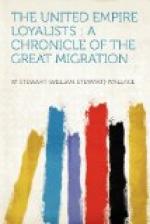There was little money in the settlements. What little there was came in pay to the soldiers or the half-pay officers. Among the greater part of the population, business was carried on by barter. In Upper Canada the lack of specie was partly overcome by the use of a kind of paper money. ’This money consists of small squares of card or paper, on which are printed promissory notes for various sums. These notes are made payable once a year, generally about the latter end of September at Montreal. The name of the merchant or firm is subscribed.’ This was merely an extension of the system of credit still in use with country merchants, but it provided the settlers with a very convenient substitute for cash. The merchants did not suffer, as frequently this paper money was lost, and never presented; and cases were known of its use by Indians as wadding for their flint-locks.
Social instincts among the settlers were strongly marked. Whenever a family was erecting a house or barn, the neighbours as a rule lent a helping hand. While the men were raising barn-timbers and roof-trees, the women gathered about the quilting-frames or the spinning-wheels. After the work was done, it was usual to have a festival. The young men wrestled and showed their prowess at trials of strength; the rest looked on and applauded. In the evening there was a dance, at which the local musician scraped out tuneless tunes on an ancient fiddle; and there was of course hearty eating and, it is to be feared, heavy drinking.
Schools and churches were few and far between. A number of Loyalist clergy settled both in Nova Scotia and in Upper Canada, and these held services and taught school in the chief centres of population. The Rev. John Stuart was, for instance, appointed chaplain in 1784 at Cataraqui; and in 1786 he opened an academy there, for which he received government aid. In time other schools sprang up, taught by retired soldiers or farmers who were incapacitated for other work. The tuition given in these schools was of the most elementary sort. La Rochefoucauld, writing of Cataraqui in 1795, says: ’In this district are some schools, but they are few in number. The children are instructed in reading




